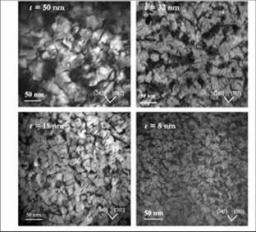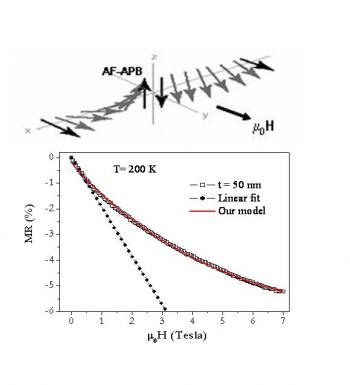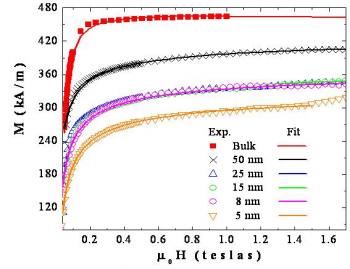

Figure 1: Dark-field TEM images of Fe3O4 films of 50, 32, 15 and 8 nm thickness in plane view obtained by selecting one of the three (200)-type reflections of Fe3O4 lattice along the [111] zone axis. The dark lines correspond to the APBs (Coll. C. Gatel, P. Bayle-Guillemaud DRFMC-SP2M, E. Snoeck, CEMES-CNRS).
Fe3O4 is a very attractive material for applications involving spin-dependent transport at room temperature as this ferromagnetic oxide has a high Curie temperature (Tc= 858 K) and is predicted to be half-metallic. However, the potential applications of Fe3O4 layers in devices relies on the assumption that the magnetic and transport properties in the thin films are similar to those in the bulk material. Several studies have shown that the magnetic behaviour, resistivity, and magnetoresistance strongly deviate from the bulk due to the presence of antiphase boundaries (APBs) in the films. An APB is a stacking fault in the iron cation sublattice which can produce a new magnetic ordering and new magnetic couplings across the APBs. The aim of this section is to analyze rigorously the relationships between the APB density and the anomalous magnetic and magnetotransport properties observed in thin films. Epitaxial Fe3O4(111) thin films of thickness varying from 5 nm to 50 nm were deposited on a-Al2O3(0001) substrates by atomic oxygen plasma-assisted molecular beam epitaxy (MBE). The real time evolution of the film growth was monitored by reflection high-energy electron diffraction (RHEED) in order to verify the high crystalline quality. In addition, in situ X-ray photoemission spectroscopy (XPS), X-ray diffraction, high resolution transmission electron microscopy (HRTEM) measurements and plane view analyses were performed to characterize the structural and chemical properties of the magnetite films of all thicknesses. Figure 1 presents the dark-field images in plane view of Fe3O4 layers of varying thickness. These images qualitatively demonstrate the effect of the film thickness on antiphase domain size, i.e. the decrease in domain size with decreasing film thickness. In order to more quantitatively analyze the evolution of the antiphase domain size as a function of the film thickness, we have shown, in agreement with the work of Eerenstein et al. [1], that this average domain size varies as t1/2, where t is the film thickness. The thickness dependence of the APBs density could be derived from the antiphase domain size and varies as t-1/2 [2], [3]. This direct relationship between film thickness and APBs density has been used to study the influence of such structural defects on magnetic and magnetotransport properties observed in thin films.
At first, a detailed study of the evolution of the magnetic properties has been performed as a function of film thickness. We have observed by SQUID, VSM magnetometry and polarized neutrons reflectometry that the magnetic moment (figure 2) is lower than that of bulk samples. In addition, the magnetic saturation is never reached. It has been shown that across an APB a strong antiferromagnetic (AF) coupling might exist. The thin films can then be described as ferromagnetic domains bounded by APBs with an antiparallel magnetic ordering at the interfaces. In order to quantify the impact of these APBs on the magnetic behaviour, we have described the approach to saturation by using the model, first introduced by B. Dieny et al. [4], of a linear chain with AF-coupled ferromagnetic domains. Considering the competition between Zeeman energy and exchange energy, the minimization of the energy leads to the relationship: M=M∞(1-b/sqrt(H)). Figure 2 displays the approach to saturation of bulk sample and thin films for different thicknesses. The curves of thin films were fitted by this model (M∞, b being the fits parameters). Within the accuracy in the fitting procedure, the b parameter decreases when the film thickness increases, hence when the APBs density decreases. However this evolution is not linear, because the characteristic length of the APB network is rather small, while our model relies on the assumption of semi-infinite chains.

Figure 3: Upper panel: Spin orientation of two semi-infinite ferromagnetic chains with antiferromagnetic (AF) coupling at the boundary subject to a magnetic field. Lower panel: magnetoresistance (MR) curve obtained at T= 200 K for a 50 nm thick Fe3O4(111) thin film with the fits using a linear MR(H) relation or our model.
We have also studied the in-plane resistivity of patterned Fe3O4(111) thin films as a function of the applied magnetic field at fixed temperatures. The magnetoresistance (MR) curves have been performed with a magnetic field applied parallel to the current direction up to 7 T. We have observed a systematic increase in the absolute value of the MR from the thickest film to the thinnest film. In order to reproduce these experimental results, we have revisited a model, previously developed by Eerenstein et al. [5] where a linear relationship for the MR induced over many AF-APBs has been found:
MR= -C(M∞/WAF)μ0H; C being a constant which depends on the volume fraction of APBs in the films and WAF a parameter related to the exchange stiffness constants.
The authors claim that this expression correctly fits the curves at very low field (linear fit of figure 3). But in this range, the magnetic hysteresis loop is open (irreversible state) and the film is not in the saturated state required by the ferromagnetic spin chain model. In order to describe our MR(H) curves over a satisfactory portion of curve, we have established a new expression for the MR, based on the same linear chain model as for the study of magnetic saturation:
MR= -C[(M∞/WAF)μ0H- ((M∞/WAF)μ0H)3/2]
This model successfully reproduces the MR curves (figure 3) over the given range of applied magnetic field [6]. This model also suggests that the MR curves are governed by two parameters, M∞ and C, whose evolution as a function of film thickness parallels that of the APB domain size and APB density respectively. We therefore ascertain that the slow approach to magnetic saturation and the MR properties in magnetite thin films are driven by the AF couplings introduced by the important number of APBs in the films.
REFERENCES:
[1] W. Eerenstein et al., Phys. Rev. B. 68, 014428 (2003).
[2] J.-B. Moussy et al., Phys. Rev. B 70, 174448 (2004).
[3] A. M. Bataille, Ph.D. thesis, University Paris XI (2005) ;
A. M. Bataille et al., Phys. Rev. B. 74, 155438 (2006).
[4] B. Dieny, D. Givord and J. M. B. Ndjaka, J. Magn. Magn. Mater. 93, 503 (1991).
[5] W. Eerenstein et al., Phys. Rev. Lett. 88, 247204 (2002).
[6] A. V. Ramos et al., J. Appl. Phys. 100, 103902 (2006).
•  Électronique et optique du futur › Nanomagnétisme et oxydes : spintronique, matériaux multiferroïques et nouveaux capteurs magnétiques
Électronique et optique du futur › Nanomagnétisme et oxydes : spintronique, matériaux multiferroïques et nouveaux capteurs magnétiques
• Service de Physique et Chimie des Surfaces et des Interfaces • Laboratory of Physics and Chemistry of Surfaces and Interfaces
• Laboratoire des Interfaces et Surfaces d'oxydes (LISO) • Laboratory of Oxide Surfaces and Interfaces













